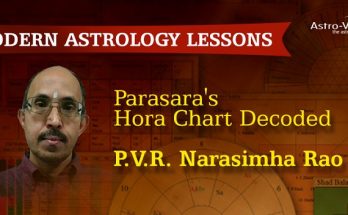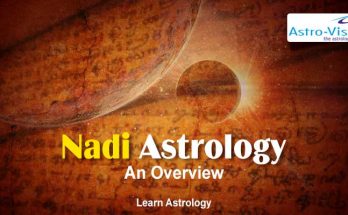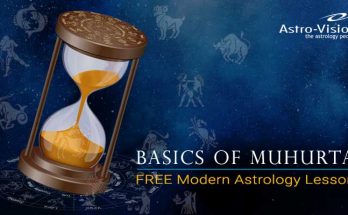Predicting precisely the time of materialization of an event is one of the hardest nuts to crack in astrology. Parasara has propounded various planetary and Rasi Dasas. However, one is aware of the difficulties in predicting an event even when following the time tested Vimshottari method because, the duration of the Antara can range anywhere between 3.5 months (Sun-Sun = 3 months 18 days) to 3.5 years (Venus-Venus = 3years 4 months). Some experts use the Vidasas and Sookshma Dasas also which is difficult for an average astrologer to apply. As a supplement, one can combine transits with the Vimshottari Dasa for the precise timing of an event.
The Dasa systems propounded by Jaimini are powerful indeed in predicting events but they have their own drawbacks because of different interpretations given by different scholars. Imagine a Dasa system which can broadly indicate the events that can occur in a year in the life of a native? How would it be if one could arrive at the particular year of a Vimshottari Antara for an event to manifest which can then be zeroed in with the aid of transits? The Rasi Tulya Vatsara Dasa is precisely such a system.
Each Rasi of the natal chart represents one year in the life of the native, the first year starting with the Ascendant in Rasi Tulya Vatsara Dasa. Events that can happen in the life of the native in that particular year can be predicted by judging the concerned Rasi in the Rasi chart. This method though simple has proved very effective in practice. When this method is combined with Vimshottari Dasa and transits it is found that an event can be predicted precisely even upto a few days. This method, when applied by an astrologer proficient in various planetary combinations, can give a birds eye-view of the entire life of the native in terms of the major events and the age at which they take place.
This is not a new method but forms the basis of the Sudarsana Chakra Dasa and is extensively used in Nadi texts for timing events. The concept of Muntha used in the Tajaka system of Hindu astrology which is based on the annual return of the Sun to its natal position is similar to this method. Even classical texts carry the germ of this idea when they say that an infant may face danger at an age identical to the sign having malefic combinations. Further, the division of Ayurdaya into Balarishta upto the 8th year, Yogarishta upto the 20th year and Alpayu upto the 32nd year has its logic based on this method. However, my humble effort has taken the form of the discovery of the way this method can be practically applied to predict any kind of major event by formulating general rules, and special rules. I have given it the nomenclature Rasi Tulya Vatsara Dasa to denote the way this system works — one sign representing one year in the life of a native as shown in Table
| House | Age in Years | |||||||||
| 1st | 1 | 13 | 25 | 37 | 49 | 61 | 73 | 85 | 97 | 109 |
| 2nd | 2 | 14 | 26 | 38 | 50 | 62 | 74 | 86 | 98 | 110 |
| 3rd | 3 | 15 | 27 | 39 | 51 | 63 | 75 | 87 | 99 | 111 |
| 4th | 4 | 16 | 28 | 40 | 52 | 64 | 76 | 88 | 100 | 112 |
| 5th | 5 | 17 | 29 | 41 | 53 | 65 | 77 | 89 | 101 | 113 |
| 6th | 6 | 18 | 30 | 42 | 54 | 66 | 78 | 90 | 102 | 114 |
| 7th | 7 | 19 | 31 | 43 | 55 | 67 | 79 | 91 | 103 | 115 |
| 8th | 8 | 20 | 32 | 44 | 56 | 68 | 80 | 92 | 104 | 116 |
| 9th | 9 | 21 | 33 | 45 | 57 | 69 | 81 | 93 | 105 | 117 |
| 10th | 10 | 22 | 34 | 46 | 58 | 70 | 82 | 94 | 106 | 118 |
| 11th | 11 | 23 | 35 | 47 | 59 | 71 | 83 | 95 | 107 | 119 |
| 12th | 12 | 24 | 36 | 48 | 60 | 72 | 84 | 96 | 108 | 120 |
Gregorian Year
The main question that needs to be considered in this system is the duration of a year. The year has different connotations based on the varying systems of commensuration like solar year, lunar year, sidereal year, astronomical year etc. The Julian calendar based on the time taken for the earth to complete one revolution around the Sun has a duration of 365-25 days. The Gregorian calendar which is in vogue today has a duration of 365 days in normal years and 366 days in a leap year. I feel that the Gregorian calendar can be applied in all cases for all practical purposes and with satisfactory results.
After applying this Dasa system to a number of charts I have formulated the following general rules. I urge the learned readers to study horoscopes in the light of these rules. Specific rules applicable to specific events will be submitted in the course of further parts of this series.
General Rules
(i) Prominence is given to the Rasi chart. Each sign is considered as a house irrespective of the conventional Bhava chart (either by equal house division or by Sripati Paddhati).
(ii) Karakattwas attributed to the signs, houses and planets have greater significance in predicting the events.
(iii) While judging a year, consider the house where the lord of the sign is placed. Events indicated by the house occupied by the sign lord will have primary importance. Also, study other planetary influences on the Rasi lord by way of conjunctions and aspects. This is because, the Karakattwas of the houses whose lords join the Rasi lord will also gain prominence in the year.
(iv) The next in significance is the Nakshatra in which the lord of the concerned sign is placed.The events indicated by the lord of the Nakshatra occupied by the lord of the sign will be felt significantly.
(v) The next in importance is the sign itself. The Karakattwas of the house represented by the sign will have general significance throughout the year.
(vi) The position of the sign with reference to the Chandra Lagna or the Moon-sign should also be considered.
(vii) Always specific combinations pertaining to the events in question should be considered in coming to conclusions.
(viii) When the year in question refers to a sign whose lord has ownership over two signs, then the events represented by the other sign show their effects predominantly. For example, in the case of a native born in Leo Ascendant, the 65th year represents the 5th house whose lord is Jupiter. However, Jupiter also owns the 8th house and hence the events related to the 8th house like death, accidents etc can also be anticipated in the 65th year.
(ix) The event will occur in decreasing order of certainty as follows in:-
(i) The year whose Rasi lord occupies the concerned Bhava.
(ii) The year whose Rasi lord occupies the Nakshatra of a planet who owns or occupies the concerned Bhava.
(iii) The year whose lord joins the concerned Bhava lord;
(iv) The year whose Rasi is placed in the concerned Bhava from the Ascendant.
(x) When the Rasi in question and/or its lord has the influence of two or more natural benefics by way of conjunction or aspect, the year will prove to be highly beneficial in all respects while the Rasi and/or its lord under the influence of two or more natural malefics, either by conjunction or aspect, will be a tough one full of mishaps and problems.
(xi) The year whose Rasi lord is with the lords of the 6th, 8th or 12th and afflicted by malefics will prove bad in respect of the significations of the house where the Rasi lord is posited.
(xii) Conversely, the year will prove beneficial in respect of the significations of the house occupied by its lord when he is conjoined by lords of Trikonas (trines) and Kendras (angles) and aspected by benefic planets.
(xiii) Any good event happening in a Rasi year whose Rasi has benefic combinations but whose lord is in Dustanas suffering affliction will be short lived and subsequently become a source of misery.
(xiv) In this system, the concept of cancellation of debility of planets does not appear to be applicable, especially in matters of health, accident and death. Hence cancellation of debility may be ignored here.
(xv) The succeeding year should also be considered in judgment, especially of events of long range significance such as political position, job etc., when the current year nears it ending. In my opinion a one month period may be considered as the overlap.
(xvi) Though past events will be explained solely on the basis of Rasi Tulya Vatsara Dasa system in the illustrations presented in this series, I request readers to integrate the Vimshottari Dasa or any other robust Dasa along with transits to predict future events.
(xvii) The 12 signs rotate in 12 years and hence each sign is activated every 12th year. The very logical question that strikes one is whether the same events will take place every 12th year. My answer is both yes and no. I have seen cases where the same pattern of events occur whenever the Rasi is activated and also some cases when it does not. Among the different Karakattwas of signs, houses and planets definitely some of them will be activated. Here we can get help from Vimshottari Dasa or Rasi Dasas and also transits.
No tool in astrology or for that matter any other science is 100 percent fool proof. There will be always cases where this system may not give satisfactory results. Nevertheless, I have obtained quite encouraging results in my humble experience. The secret to successful prediction, however, lies in the convergence of more than two tools.
This method can be further improved by integrating the following also:-
(i) Vimshottari or any other planetary Dasa.
(ii) Rasi Dasas like Chara Dasa, Padanadhamsa Dasa etc.
(iii) Transit influences in triggering events.
(iv) Extending the Rasi Tulya Vatsara Dasa system to the respective divisional charts for specific events shown by them.
(v) Considering the Tajaka system.
(vi) Including the Moon-sign and Sun-sign as Ascendants along with the Ascendant proper.
(vii) Applying the Jaimini system through Rasi aspects, Arudhas, Argalas, Chara Karakas etc.
I am sure this system can open new vistas for the research-oriented in astrology. •







